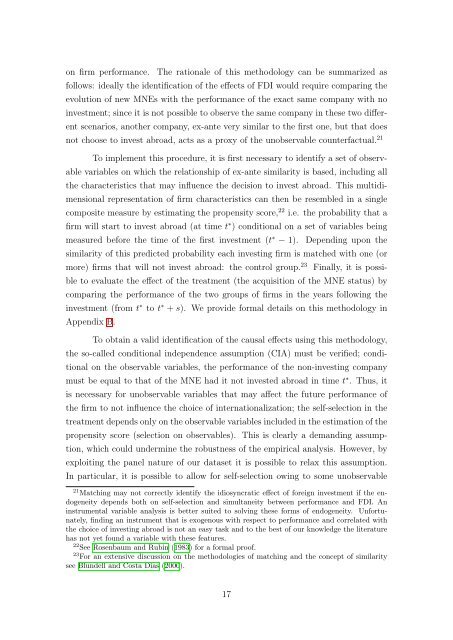n?u=RePEc:bdi:wptemi:td_1011_15&r=eff
n?u=RePEc:bdi:wptemi:td_1011_15&r=eff
n?u=RePEc:bdi:wptemi:td_1011_15&r=eff
- No tags were found...
You also want an ePaper? Increase the reach of your titles
YUMPU automatically turns print PDFs into web optimized ePapers that Google loves.
on firm performance.The rationale of this methodology can be summarized asfollows: ideally the identification of the effects of FDI would require comparing theevolution of new MNEs with the performance of the exact same company with noinvestment; since it is not possible to observe the same company in these two differentscenarios, another company, ex-ante very similar to the first one, but that doesnot choose to invest abroad, acts as a proxy of the unobservable counterfactual. 21To implement this procedure, it is first necessary to identify a set of observablevariables on which the relationship of ex-ante similarity is based, including allthe characteristics that may influence the decision to invest abroad. This multidimensionalrepresentation of firm characteristics can then be resembled in a singlecomposite measure by estimating the propensity score, 22 i.e. the probability that afirm will start to invest abroad (at time t ∗ ) conditional on a set of variables beingmeasured before the time of the first investment (t ∗ − 1).Depending upon thesimilarity of this predicted probability each investing firm is matched with one (ormore) firms that will not invest abroad: the control group. 23Finally, it is possibleto evaluate the effect of the treatment (the acquisition of the MNE status) bycomparing the performance of the two groups of firms in the years following theinvestment (from t ∗ to t ∗ + s). We provide formal details on this methodology inAppendix B.To obtain a valid identification of the causal effects using this methodology,the so-called conditional independence assumption (CIA) must be verified; conditionalon the observable variables, the performance of the non-investing companymust be equal to that of the MNE had it not invested abroad in time t ∗ . Thus, itis necessary for unobservable variables that may affect the future performance ofthe firm to not influence the choice of internationalization; the self-selection in thetreatment depends only on the observable variables included in the estimation of thepropensity score (selection on observables). This is clearly a demanding assumption,which could undermine the robustness of the empirical analysis. However, byexploiting the panel nature of our dataset it is possible to relax this assumption.In particular, it is possible to allow for self-selection owing to some unobservable21 Matching may not correctly identify the idiosyncratic effect of foreign investment if the endogeneitydepends both on self-selection and simultaneity between performance and FDI. Aninstrumental variable analysis is better suited to solving these forms of endogeneity. Unfortunately,finding an instrument that is exogenous with respect to performance and correlated withthe choice of investing abroad is not an easy task and to the best of our knowledge the literaturehas not yet found a variable with these features.22 See Rosenbaum and Rubin (1983) for a formal proof.23 For an extensive discussion on the methodologies of matching and the concept of similaritysee Blundell and Costa Dias (2000).17



